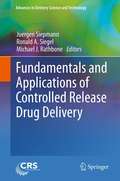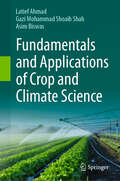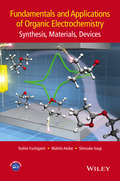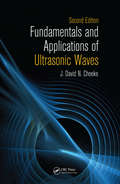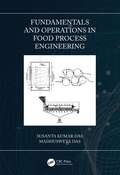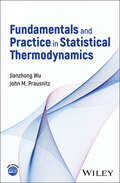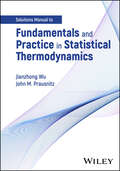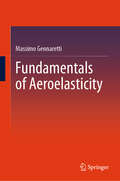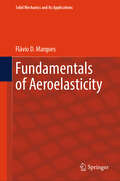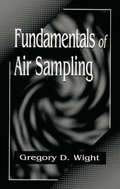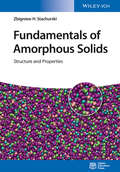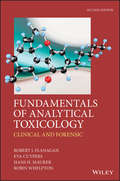- Table View
- List View
Fundamentals and Applications of Controlled Release Drug Delivery
by Michael J. Rathbone Juergen Siepmann Ronald A. SiegelThis book approaches the subject from a mechanistic perspective that pitches the language at a level that is understandable to those entering the field and who are not familiar with its common phrases or complex terms. It provides a simple encapsulation of concepts and expands on them. In each chapter the basic concept is explained as simply and clearly as possible without a great deal of detail, then in subsequent sections additional material, exceptions to the general rule, examples, etc., is introduced and built up. Such material was generously supplemented with diagrams; conceptually elegant line diagrams in two or three colors. The artwork was well thought out and able to condense the scientific principles into a novel and visually exciting form. The diagrams encourage browsing or draw the reader to salient points. In addition, the technique of highlighting key concepts in a separate box is used throughout each chapter.
Fundamentals and Applications of Crop and Climate Science
by Latief Ahmad Asim Biswas Gazi Mohammad ShahThis book encompasses all aspects and perspectives of crop and climate science. It aims to serve as the authoritative resource for undergraduate students seeking answers and insights into the field of crop science and agro meteorology. The book covers a wide range of topics, starting from the foundational principles of crops and extending to various meteorological phenomena. It is built upon the latest research in crop science and agro-meteorology, providing clear and concise explanations without unnecessary filler content. The transitions between topics are smooth and coherent, ensuring optimal comprehension. The initial chapters focus on the fundamental principles of crop science, while the later sections delve into the concepts and practices of agro-meteorology. This book is specifically designed for advanced undergraduate students and beyond studying crops, meteorology, horticulture, forestry, fisheries, and related fields. Special care has been taken by authors to match the content with current scenario and advancement in the field of agriculture sciences.
Fundamentals and Applications of Micro- and Nanofibers
by Alexander L. Yarin Alexander L. Yarin Behnam Pourdeyhimi Seeram Ramakrishna Behnam PourdeyhimiA comprehensive exposition of micro and nanofiber forming, this text provides a unified framework of all these processes (melt and solution blowing, electrospinning, and so on) and describes their foundations, development and applications. It provides an up-to-date, in-depth physical and mathematical treatment, and discusses a wide variety of applications in different fields, including nonwovens, energy, healthcare and the military. It further highlights the challenges and outstanding issues from an interdisciplinary perspective of science and technology, incorporating both fundamentals and applications. Ideal for researchers, engineers and graduate students interested in the formation of micro and nanofibers and their use in functional smart materials.
Fundamentals and Applications of Organic Electrochemistry
by Mahito Atobe Shinsuke Inagi Toshio FuchigamiThis textbook is an accessible overview of the broad field of organic electrochemistry, covering the fundamentals and applications of contemporary organic electrochemistry. The book begins with an introduction to the fundamental aspects of electrode electron transfer and methods for the electrochemical measurement of organic molecules. It then goes on to discuss organic electrosynthesis of molecules and macromolecules, including detailed experimental information for the electrochemical synthesis of organic compounds and conducting polymers. Later chapters highlight new methodology for organic electrochemical synthesis, for example electrolysis in ionic liquids, the application to organic electronic devices such as solar cells and LEDs, and examples of commercialized organic electrode processes. Appendices present useful supplementary information including experimental examples of organic electrosynthesis, and tables of physical data (redox potentials of various organic solvents and organic compounds and physical properties of various organic solvents).
Fundamentals and Applications of Ultrasonic Waves
by J. David CheekeWritten at an intermediate level in a way that is easy to understand, Fundamentals and Applications of Ultrasonic Waves, Second Edition provides an up-to-date exposition of ultrasonics and some of its main applications. Designed specifically for newcomers to the field, this fully updated second edition emphasizes underlying physical concepts over mathematics. The first half covers the fundamentals of ultrasonic waves for isotropic media. Starting with bulk liquid and solid media, discussion extends to surface and plate effects, at which point the author introduces new modes such as Rayleigh and Lamb waves. This focus on only isotropic media simplifies the usually complex mathematics involved, enabling a clearer understanding of the underlying physics to avoid the complicated tensorial description characteristic of crystalline media. The second part of the book addresses a broad spectrum of industrial and research applications, including quartz crystal resonators, surface acoustic wave devices, MEMS and microacoustics, and acoustic sensors. It also provides a broad discussion on the use of ultrasonics for non-destructive evaluation. The author concentrates on the developing area of microacoustics, including exciting new work on the use of probe microscopy techniques in nanotechnology. Focusing on the physics of acoustic waves, as well as their propagation, technology, and applications, this book addresses viscoelasticity, as well as new concepts in acoustic microscopy. It updates coverage of ultrasonics in nature and developments in sonoluminescence, and it also compares new technologies, including use of atomic force acoustic microscopy and lasers. Highlighting both direct and indirect applications for readers working in neighboring disciplines, the author presents particularly important sections on the use of microacoustics and acoustic nanoprobes in next-generation devices and instruments.
Fundamentals and Operations in Food Process Engineering
by Susanta Kumar Das Madhusweta DasFundamentals and Operations in Food Process Engineering deals with the basic engineering principles and transport processes applied to food processing, followed by specific unit operations with a large number of worked-out examples and problems for practice in each chapter. The book is divided into four sections: fundamentals in food process engineering, mechanical operations in food processing, thermal operations in food processing and mass transfer operations in food processing. The book is designed for students pursuing courses on food science and food technology, including a broader section of scientific personnel in the food processing and related industries.
Fundamentals and Practical Aspects of Gas Injection (Petroleum Engineering)
by Reza Azin Amin IzadpanahiThis book covers different aspects of gas injection, from the classic pressure maintenance operation to enhanced oil recovery (EOR), underground gas storage (UGS), and carbon capture and storage (CCS). The authors detail the unique characteristics and specific criteria of each application, including: material balance equationsphase behaviourreservoir engineeringwell designoperating aspectssurface facilitiesenvironmental issues Examples, data, and simulation codes are provided to enable the reader to gain an in-depth understanding of these applications. Fundamentals and Practical Aspects of Gas Injection will be of use to practising engineers in the fields of reservoir engineering, and enhanced oil recovery. It will also be of interest to researchers, academics, and graduate students working in the field of petroleum engineering.
Fundamentals and Practice in Statistical Thermodynamics
by Jianzhong Wu John M. PrausnitzBridge the gap between thermodynamic theory and engineering practice with this essential textbook Thermodynamics is a discipline which straddles the fields of chemistry, physics, and engineering, and has long been a mainstay of undergraduate and graduate curricula. Conventional thermodynamics courses, however, often ignore modern developments in statistical mechanics, such as molecular simulation methods, cooperative phenomena, phase transitions, universality, as well as liquid-state and polymer theories, despite their close relevance to both fundamental research and engineering practice. Fundamentals and Practice in Statistical Thermodynamics fills this gap with an essential book that applies up-to-date statistical-mechanical techniques to address the most crucial thermodynamics problems found in chemical and materials systems. It is ideally suited to introduce a new generation of researchers and molecular engineers to modern thermodynamic topics with numerous cutting-edge applications. From Fundamentals and Practice in Statistical Thermodynamics readers will also find: An introduction to statistical-mechanical methods including molecular dynamics simulation, Monte Carlo simulation, as well as the molecular theories of phase transitions, classical fluids, electrolyte solutions, polymeric materials, and more Illustrative examples and exercise problems with solutions to facilitate student understandingSupplementary online materials covering the basics of quantum mechanics, density functional theory, variational principles of classical mechanics, intermolecular interactions, and many more subjects Fundamentals and Practice in Statistical Thermodynamics is ideal for graduate and advanced undergraduate students in chemical engineering, biomolecular engineering, environmental engineering, materials science and engineering, and all related scientific subfields of physics and chemistry.
Fundamentals and Practice in Statistical Thermodynamics, Solutions Manual
by Jianzhong Wu John M. PrausnitzThis is a solutions manual to accompany Fundamentals and Practice in Statistical Thermodynamics This textbook supplements, modernizes, and updates thermodynamics courses for both advanced undergraduates and graduate students by introducing the contemporary topics of statistical mechanics such as molecular simulation and liquid-state methods with a variety of realistic examples from the emerging areas of chemical and materials engineering. Current curriculum does not provide the necessary preparations required for a comprehensive understanding of these powerful tools for engineering applications. This text presents not only the fundamental ideas but also theoretical developments in molecular simulation and analytical methods to engineering students by illustrating why these topics are of pressing interest in modern high-tech applications.
Fundamentals and Principles of Electromagnetic Wave Absorbers: From Theory, Design, and Materials to Measurement (Springer Series in Advanced Microelectronics #66)
by Sung-Soo KimThis book consists of three main parts: fundamental theory, design principles and methodology, and potential materials that can be applied to EM wave absorbers. In the theory part, this book provides the basics of electromagnetism, circuit and transmission line theory, EM wave propagation and reflection, and complex permittivity and permeability by electric polarization and magnetization of materials. In the design part, design methods are explained for various types of EM wave absorbers based on equivalent circuit models and simulation technologies. Starting from the traditional resonance-type absorber, this book reviews the latest metamaterial and frequency selection surface (FSS) absorbers with more advanced design techniques. Recent research results are also included associated with how to design the ultrawide-bandwidth absorbers through multilayering FSSs or shape-control of lossy materials. In the materials section, various lossy materials are reviewed that can be used as EM wave absorbers, including conductive materials, magnetic materials, dielectric materials, core-shell materials, fiber-reinforced composite materials, and metamaterials or metasurfaces. Literature reviews on their electromagnetic properties and EM wave absorption performance are also presented. Finally, the methods and principles for measuring the high-frequency properties (complex permittivity and permeability) and EM wave absorption are described.
Fundamentals of 57Fe Mössbauer Spectrometry
by R. Justin Joseyphus Jean-Marc GrenecheThis book highlights the fundamental concepts related to 57Fe Mössbauer spectrometry, useful for graduate students and researchers. The first three chapters present essential topics related to nuclear, quantum mechanics and magnetism. The final parts of the book focus on the fundamentals and applications of 57Fe Mössbauer spectrometry. As Mössbauer spectrometry is used by students and researchers in various disciplines, this book presents the essential aspects in the relevant subject areas. The Mössbauer parameters of Fe-based alloys, ferrimagnetic, antiferromagnetic and superconducting materials, as well as applications in earth sciences, life sciences and extraterrestrial studies, are covered.
Fundamentals of Abnormal Psychology (7th Edition)
by Ronald J. ComerThis edition has an expanded and updated coverage of Abnormal Psychology that includes key disorders, prevention, recent theories, research, and promotion of mental health.
Fundamentals of Acoustic Waves and Applications (Synthesis Lectures on Wave Phenomena in the Physical Sciences)
by Sanichiro YoshidaThis book discusses acoustic waves in five chapters. Chapter 1 reviews the general properties of waves. Chapter 2 presents the acoustic waves in fluid and solids, including the wave equations in the respective media. Chapter 3 discusses the propagation of audible acoustic waves in the air. The discussion includes analyses of speech and music we hear in the time and frequency domains. Chapter 4 discusses the propagation of acoustic waves in solids. Unlike in the air, sound waves take complicated forms in solids; they can be both in longitudinal and transverse modes, and mode conversions can occur upon reflection. Although these behaviors make the analysis difficult, we can apply them to engineering problems. Chapter 5 describes the transduction of acoustic signals. It presents acoustic transmitters and sensors along with their operation principles. Finally, Chapter 6 presents several techniques used in engineering. It is also useful to consider applying acoustic and optical techniques to engineering problems.
Fundamentals of Acoustics
by Michel BruneauThe central theme of the chapters is acoustic propagation in fluid media, dissipative or non-dissipative, homogeneous or nonhomogeneous, infinite or limited, placing particular emphasis on the theoretical formulation of the problems considered.
Fundamentals of Aerodynamics
by John D. AndersonFundamentals of Aerodynamics is meant to be read. The writing style is intentionally conversational in order to make the book easier to read. The book is designed to talk to the reader; in part to be a self-teaching instrument. Learning objectives have been added to each chapter to reflect what is believed to be the most important items to learn from that particular chapter. This edition emphasizes the rich theoretical and physical background of aerodynamics, and marbles in many historical notes to provide a background as to where the aerodynamic technology comes from. Also, new with this edition, are "Integrated Work Challenges" that pertain to the chapter as a whole, and give the reader the opportunity to integrate the material in that chapter, in order to solve a "bigger picture". McGraw-Hill's Connect, is also available as an optional, add on item. Connect is the only integrated learning system that empowers students by continuously adapting to deliver precisely what they need, when they need it, how they need it, so that class time is more effective. Connect allows the professor to assign homework, quizzes, and tests easily and automatically grades and records the scores of the student's work. Problems are randomized to prevent sharing of answers an may also have a "multi-step solution" which helps move the students' learning along if they experience difficulty.
Fundamentals of Aeroelasticity
by Massimo GennarettiThis textbook provides the fundamentals of aeroelasticity, with particular attention to problems of interest to aeronautical engineering. The mathematical methods and tools applicable to the modern modeling of general aeroelastic problems are presented, discussed, and applied to fixed-wing aircraft configurations. It is composed of ten chapters divided into two parts: (I) aeroelastic modeling and analysis and (ii) mathematical tools. The six chapters that compose the first part start from the historical background of the discipline, then present the methods for coupling structural dynamics and unsteady aerodynamics for the aeroelastic modeling of the typical wing section, and then extend them to applications for twisted, tapered, swept finite-wing configurations. In this context, particular attention is paid to the presentation, interpretation, and discussion of the available unsteady sectional aerodynamic theories, both in the time and frequency domain, providing a broad scenario of the formulations that can be used for conventional and non-conventional aerodynamic/aeroelastic applications. For a modern view of aeroelasticity, a significant portion of the textbook deals with illustration and discussion of three-dimensional aerodynamic theories and computational methods for the determination of unsteady aerodynamic loads over lifting bodies in incompressible and compressible flows, as well as to the introduction and explanation of methodologies for the identification of reduced-order, state-space aerodynamic/aeroelastic operators suitable for stability (flutter) analysis and control purposes. A chapter is dedicated to the theories and approaches for aeroservoelastic modeling. In the second part of the textbook, additional chapters provide theoretical insights on topics that enrich the multidisciplinary knowledge related to widely applied methods and models for the analysis and solution of aeroelastic problems. The book serves as a reference tool for master's degree students in aeronautical/aerospace engineering, as well as researchers in the field of aeroelasticity.
Fundamentals of Aeroelasticity (Solid Mechanics and Its Applications #279)
by Flávio D. MarquesThis book delves into the fundamentals of aeroelasticity, providing a modern foundation for education and research in aeronautical engineering. It begins with a brief introduction to aeroelasticity and then explores the static stability of airfoils and wings, using elementary models to solve fluid-structure interaction problems under equilibrium conditions. The dynamics of the typical aeroelastic section are examined, including modal analysis and dynamic characterization. Analytical and numerical aerodynamic models are discussed for unsteady aerodynamics, offering tools for studying stability phenomena and calculating aeroelastic responses. The text covers aeroelastic response and stability analysis, demonstrating coupled aerodynamic models' behavior under varying parameters and predicting flutter phenomena. The dynamic aeroelasticity of wings is analyzed, presenting a time-domain simulation model to show flutter conditions and aeroelastic modes. Appendices provide insights on finite element modeling of beams, self-excited systems, and surface interpolation methods, with numerous examples for result replication, though no specific computational tools are suggested.
Fundamentals of Air Cleaning Technology and Its Application in Cleanrooms
by Zhonglin XuFundamentals of Air Cleaning Technology and Its Application in Cleanrooms sets up the theoretical framework for cleanrooms. New ideas and methods are presented, which include the characteristic index of cleanrooms, uniform and non-uniform distribution characteristics, the minimum sampling volume, a new concept of outdoor air conditioning and the fundamentals of leakage-preventing layers. Written by an author who can look back on major scientific achievements and 50 years of experience in this field, this book offers a concise and accessible introduction to the fundamentals of air cleaning technology and its application. The work is intended for researchers, college teachers, graduates, designers, technicians and corporate R&D personnel in the field of HVAC and air cleaning technology.Zhonglin Xu is a senior research fellow at China Academy of Building Research.
Fundamentals of Air Sampling
by Gregory D. WightThere is a growing need for environmental measurement personnel who possess a solid understanding of the techniques of air pollutant sampling. This essential book explains the fundamentals of air sampling, develops the theory of gas measurement, and presents several "how-to" examples of calibration and use of air and gas sampling devices. Other topics covered range from the basics of pressure measurement and units conversion to specific discussions regarding the use of a Volatile Organic Sampling Train or a SUMMA-polished canister sampling system.
Fundamentals of Amorphous Solids: Structure and Properties
by Zbigniew H. StachurskiLong awaited, this textbook fills the gap for convincing concepts to describe amorphous solids. Adopting a unique approach, the author develops a framework that lays the foundations for a theory of amorphousness. He unravels the scientific mysteries surrounding the topic, replacing rather vague notions of amorphous materials as disordered crystalline solids with the well-founded concept of ideal amorphous solids. A classification of amorphous materials into inorganic glasses, organic glasses, glassy metallic alloys, and thin films sets the scene for the development of the model of ideal amorphous solids, based on topology- and statistics-governed rules of three-dimensional sphere packing, which leads to structures with no short, mid or long-range order. This general model is then concretized to the description of specific compounds in the four fundamental classes of amorphous solids, as well as amorphous polyethylene and poly(methyl)methacrylate, emphasizing its versatility and descriptive power. Finally, he includes example applications to indicate the abundance of amorphous materials in modern-day technology, thus illustrating the importance of a better understanding of their structure and properties. Equally ideal as supplementary reading in courses on crystallography, mineralogy, solid state physics, and materials science where amorphous materials have played only a minor role until now.
Fundamentals of Analytical Toxicology: Clinical and Forensic
by Robin Whelpton Hans H. Maurer Robert J. Flanagan Eva CuypersFundamentals of Analytical Toxicology is an integrated introduction to the analysis of drugs, poisons, and other foreign compounds in biological and related specimens. Assuming only basic knowledge of analytical chemistry, this invaluable guide helps trainee analytical toxicologists understand the principles and practical skills involved in detecting, identifying, and measuring a broad range of compounds in various biological samples. Clear, easy-to-read chapters provide detailed information on topics including sample collection and preparation, spectrophotometric and luminescence techniques, liquid and gas-liquid chromatography, and mass spectrometry including hyphenated techniques. This new edition contains thoroughly revised content that reflects contemporary practices and advances in analytical methods. Expanding the scope of the 1995 World Health Organization (WHO) basic analytical toxicology manual, the text includes coverage of separation science, essential pharmacokinetics, xenobiotic absorption, distribution and metabolism, clinical toxicological and substance misuse testing, therapeutic drug monitoring, trace elements and toxic metals analysis, and importantly the clinical interpretation of analytical results. Written by a prominent team of experienced practitioners, this volume: Focuses on analytical, statistical, and pharmacokinetic principles Describes basic methodology, including colour tests and immunoassay and enzyme-based assays Outlines laboratory operations, such as method validation, quality assessment, staff training, and laboratory accreditation Follows IUPAC nomenclature for chemical names and recommended International Non-proprietary Name (rINN) for drugs and pesticides Includes discussion of 'designer drugs' (novel pharmaceutical substances NPS) Fundamentals of Analytical Toxicology: Clinical and Forensic, 2nd Edition is an indispensable resource for advanced students and trainee analytical toxicologists across disciplines, such as clinical science, analytical chemistry, forensic science, pathology, applied biology, food safety, and pharmaceutical and pesticide development.
Fundamentals of Anatomy & Physiology (8th Edition)
by Frederic H. Martini Judi L. NathThis textbook will serve as an introduction to the inner workings of your body, providing information about both its structure and its function.
Fundamentals of Anatomy & Physiology, Tenth Edition
by Edwin F. Bartholomew Frederic H. Martini Judi L. NathFundamentals of Anatomy & Physiology helps you succeed in the challenging A&P course with an easy-to-understand narrative, precise visuals, and steadfast accuracy. Every chapter of the Tenth Edition includes one- and two-page Spotlight Figures that seamlessly integrate text and visuals to guide you through complex topics and processes.
Fundamentals of Anatomy and Physiology
by Frederic Martini Judi Nath Edwin BartholomewFundamentals of Anatomy & Physiology helps students succeed in the challenging A&P course with an easy-to-understand narrative, precise visuals, and steadfast accuracy. With the 11th Edition, the author team draws from recent research exploring how students use and digest visual information to help students use art more effectively to learn A&P. New book features encourage students to view and consider figures in the textbook, and new narrated videos guide students through complex physiology figures to help them deconstruct and better understand complicated processes. Instructors can also request a new handbook by Lori Garrett, entitled The Art of Teaching A&P: Six Easy Lessons to Improve Student Learning , which explores some of the most common challenges encountered when using art to teach A&P, alongside strategies to address these challenges.
Fundamentals of Anatomy and Physiology (6th Edition)
by Frederic H. MartiniThis text shows students the links between normal anatomy and physiology and important disease states. In the process, it teaches basic diagnostic principles and develops critical-thinking skills. It includes An Introduction to Diagnostics, with discussion of the scientific method and the techniques by which diseases are detected and identified. It provides Applied Research Topics, with discussions of genetic engineering, pathogens and infectious diseases, and cancer formation and treatment. It also provides The Body Systems, clinical and applied topics, with discussions of diagnostic tests and representative disorders for each organ system in the body.
